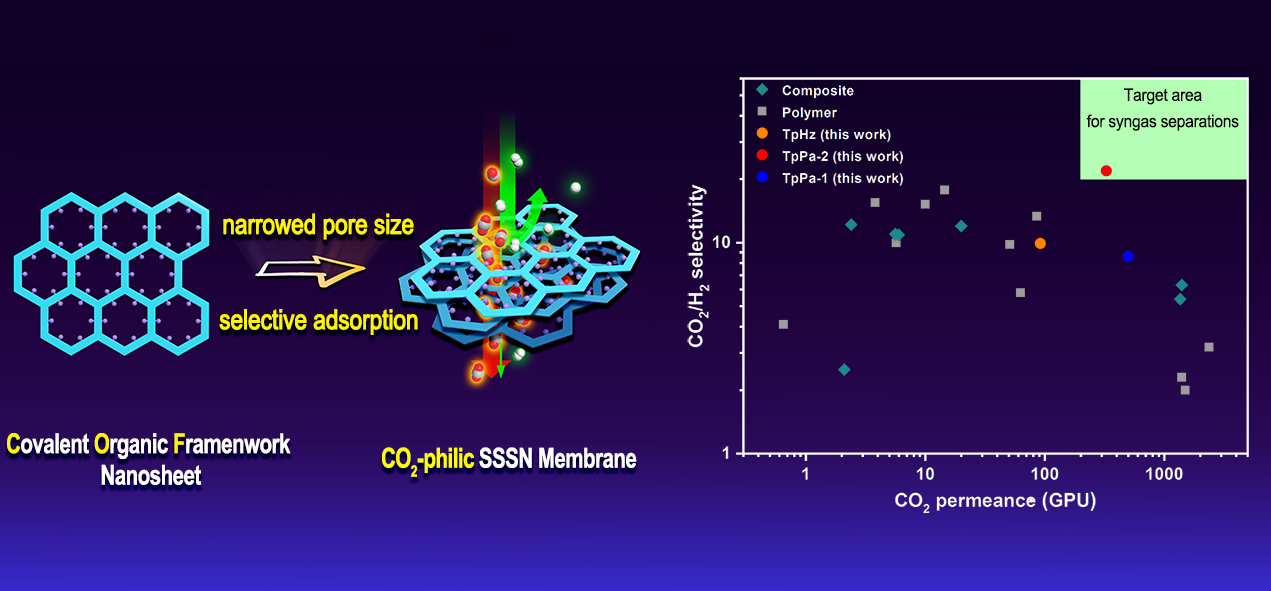Single-Phase Covalent Organic Frameworks Membranes Make CO2-selective Separation Possible
A research group led by Prof. YANG Weishen and Dr. PENG Yuan from the Dalian Institute of Chemical Physics (DICP) of the Chinese Academy of Sciences (CAS) developed a novel strategy to fabricate single-phase CO2-selective covalent organic frameworks (COFs) nanosheet membranes featured with both high CO2/H2 separation factors and high CO2 permeances.
This study was published in Angewandte Chemie International Edition on July 20.
Two-dimensional (2D) COFs, a class of crystalline organic skeletons possessing permanent one-dimensional pores, are promising to serve as high-quality membrane materials in CO2 capture field. However, their inherent pore sizes (>0.8 nm) are too large to provide desired molecular sieve capability for gas separations currently.

Illustration of superior CO2-selective COF nanosheet membrane for high-performance CO2/H2 separation (Image by PENG Yuan)
The researchers exfoliated three kinds of 2D COFs, that is, TpPa-1, TpPa-2 and TpHz (Tp=1,3,5-triformylphloroglucinol, Pa-1=benzene-1,4-diamine, Pa-2=2,5-dimethylbenzene-1,4-diamine, Hz=hydrazine), with an average particle size of 3 um and different pore sizes into 2 nm-thick nanosheets. Intact crystallinities and functionalities were well-retained after exfoliation treatment.
They found that even the TpHz with relatively smallest inherent pore size could not exhibit desired gas separation performance in a form of conventional bulk membrane. With ultrathin nanosheets served as membrane building units, they developed novel COF nanosheet membranes exhibiting distinctive staggered stacking micro-structures.
"Just like the fishing net, you can irregularly pile up several nets to catch tiny fish" said Dr. PENG.
The intriguing membrane structures in collaboration with inherent CO2-selective adsorption capacities of COF frameworks endowed the COF nanosheet membranes with permeation priority of large CO2 molecules from mixed CO2/H2 gas based on a surface diffusion mechanism.
Among the membranes, TpPa-2 nanosheet membranes with medium pore size showed the highest CO2/H2 separation factor and CO2 permeance, which reached the target with commercial feasibility for syngas separations.
The researchers identified that the TpPa-2 nanosheet membranes exhibited proper narrowed pores derived from the staggered stacking patterns, which allowed exactly two columns of CO2 molecules to pass through and maximized the blocking effect for H2 passage.
This study provides a new pore engineering strategy for the design and manufacture of high-performance COF membranes in gas separation realm.
"Taking full advantage of this pore-engineering strategy, different categories of COFs with diversified pore structures can enable specified membrane-based gas separations," said Prof. Yang.
This study was supported by the National Natural Science Foundation of China, the DNL Cooperation Fund, and the DICP Fund. (Text by PENG Yuan)